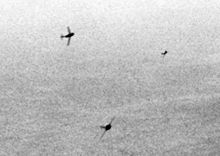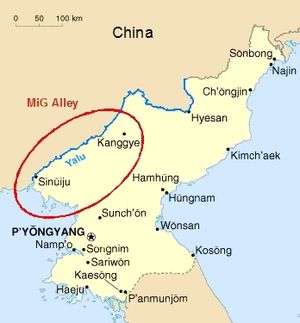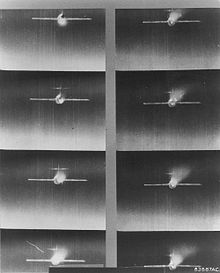- MiG Alley
-
For the game, see MiG Alley (video game).
"MIG Alley" is the name given by U.S. Air Force pilots to the northwestern portion of North Korea, where the Yalu River empties into the Yellow Sea. During the Korean War, it was the site of numerous dogfights between U.S. fighter jets and those of the Communist forces, particularly the Soviet Union, which was confirmed after the fall of the Soviet Union. The North American F-86 Sabre and the Soviet-built Mikoyan-Gurevich MiG-15 were the aircraft used throughout most of the conflict, with the area's nickname derived from the latter. Because it was the site of the first large-scale jet-vs-jet air battles, MIG Alley is considered the birthplace of jet fighter combat.
Contents
MIGs enter the scene
 MiG-15 delivered by a defecting North Korean pilot to the US Air Force.
MiG-15 delivered by a defecting North Korean pilot to the US Air Force.
The North Koreans began their war against South Korea on June 25, 1950 with a small, obsolescent air force of propeller-driven Soviet aircraft of World War II vintage flown by under-trained and inexperienced pilots. Once the United States committed its air power to the war, this force was rapidly depleted.
For several months, U.S. F-80 Shooting Star and F-84 Thunderjet fighters, along with B-29 Superfortress bombers and Navy and Marine aircraft, roamed the skies over North Korea virtually at will while the North Koreans and their Soviet and Communist Chinese backers argued behind the scenes over the best course of counter-action. By October, the Soviet Union had agreed to provide air regiments equipped with high performance MiG-15 fighters, along with the trained crews to fly them. Simultaneously, the Kremlin agreed to supply the Chinese and North Koreans with their own MiG-15s, as well as training for their pilots.[citation needed]
Secrecy
For many years, the participation of Soviet aircrews in the Korean War was widely suspected by the United Nations forces, but consistently denied by the Soviet Union. With the end of the Cold War, however, Soviet pilots who participated in the conflict have begun to reveal their role.[1]
Soviet aircraft were adorned with North Korean or Chinese markings and pilots wore either North Korean uniforms or civilian clothes, to disguise their origins. For radio communication, they were given cards with common Korean words for various flying terms spelled out phonetically in Cyrillic characters.[1] These subterfuges did not long survive the fury of air-to-air combat, however, and pilots were soon routinely communicating in Russian.
Soviet MiG-15 regiments were based on Chinese fields in Manchuria, where, according to existing U.S. rules of engagement, they could not be attacked by U.S. forces. Many Soviet regiments underwent preliminary training at Soviet bases in the neighboring Soviet Maritime Military District. Soviet air defense troops also began to arrive along the Yalu, setting up radar installations, ground control centers, searchlights and large numbers of anti-aircraft guns to deter any attacks on the Chinese airfields.
While U.S. pilots chafed at the restrictions imposed on attacking the MiG's Chinese airfields, it wasn't known until many years later that the MiG pilots themselves operated under tight restrictions. To preserve the fiction that Soviet pilots were not fighting in Korea, they were prohibited from flying over non-Communist-controlled territory or within 30 to 50 miles of the Allied front lines. (One Soviet pilot who was shot down in UN-controlled territory shot himself with his pistol rather than be taken captive. Another pilot who bailed out into the Yellow Sea was strafed to prevent him from being captured.) Nor could they pursue U.S. aircraft over the U.S.-controlled Yellow Sea.[2]
In spite of the restrictions, many U.S. pilots took advantage of a "hot pursuit" exception to flying over China to pursue MiGs across the Yalu River. Later, "hot pursuit" became active MiG hunting over Manchuria, with U.S. pilots maintaining a "code of silence" about the patrols. Flight leaders chose wingmen who would keep quiet, and many rolls of incriminating gun camera footage "mysteriously" disappeared.[2]
The U.S. conducted Operation Moolah to entice Communist pilots, especially Russian pilots, to defect to South Korea with a MiG-15.[citation needed] The operation was to serve as a psychological factor to show the superiority of democracy over communism, but also to conduct analysis of the MiG-15's flight performance.
Legacy
 F-86Fs from the 51st FIW over Korea, 1953.
F-86Fs from the 51st FIW over Korea, 1953.
 MiG-15s curving in to attack USAF B-29s, 1951.
MiG-15s curving in to attack USAF B-29s, 1951.
The MIG Alley battles produced many U.S. fighter aces. The top U.S. ace of the war, Capt. Joseph C. McConnell, claimed 16 MiGs, including three on one day. Hollywood immortalized him with The McConnell Story, starring Alan Ladd and June Allyson.[3] The second-highest-scoring U.S. ace, Maj. James Jabara, was the first U.S. jet-vs.-jet ace. Another ace, Frederick C. "Boots" Blesse, claimed nine MiG-15s in his F-86 Sabre[4] and later wrote No Guts, No Glory, a manual of air fighter combat that is still studied today.[2]
George Andrew Davis, Jr. became one of the first members of the new U.S. Air Force to receive the Medal of Honor after being killed while leading his section of two F-86s against 12 MiG-15s when he was trying to shoot them all down.
According to undocumented source(s), however, the top two fighter aces over MiG Alley were actually MiG-15 Soviet pilots: Nikolay Sutyagin (claiming 21 aircraft) and Yevgeny Pepelyaev (claiming 19).[citation needed]
It is widely held that the US Air Force maintained air superiorty throughout the war and held a significant kill ratio over communist air forces operating in and around Korea.[citation needed] The US Air Force still claims a kill ratio of 10 to 1 in their favor. The modern Russian sources indicate a kill ration of 3,4 to 1 in the Soviet favor. Some consider the "kill" totals over MiG Alley controversial. The Soviets claimed 1,106 United Nations planes of all types shot down by the VVS, including about 650 Sabres. (The USAF says it lost less than 200 aircraft in air combat). The F-86 pilots, in turn, claimed 792 MiG-15s shot down, while B-29 gunners claimed a further 16. One claim says this number was reduced to to 379 MiGs.[citation needed] The Chinese PLAAF claimed only 85 kills.[citation needed]
Over thirty Sabre pilots were claimed to have been shot down behind enemy lines and their fate has never been definitively established. Surviving pilots, captured and later repatriated after the armistice, reported being interrogated by Koreans, Russians, and Chinese. For years after the Korean War ended in 1953, rumors persist of pilots held captive by the Soviets.[5]
A number of computer video games based on the combat in MiG Alley have been produced, amongst them:
- MiG Alley Ace, released by MicroProse in 1985. [1] [2]
- Sabre Ace, Conflict Over Korea: 25 June 1950-27 July 1953 London: Eagle Interactive/Virgin Interactive, 1997. Players can use a U.S. F-86 Sabre against the MiG-15 in the Korean War.
- MiG Alley Empire Interactive/Rowan Software, 1999. A combat flight simulator of Korean War.
- "Sabre vs MiG", one add-on packet for Microsoft Combat Flight Simulator 2 from Flight 1 Just Flight.
- "Korean Combat Pilot", add-on packet for Microsoft Combat Flight Simulator 1 and 2 from Just Flight.
- "Red Star" add-on for Microsoft Combat Flight Simulator 2, a work produced by Fox Four CFS2 Korean War Project.
- Tom Clancy's HAWX 2 released a DLC entitled 'MiG Alley' the pack adds the F-86 Sabre and the MiG-15 as playable aircraft.
A section of Polish Aviation Museum, where the post-Soviet planes are stored, is called "The MiG Alley" (pl. Aleja MiGów).
See also
- List of Korean War air aces
- MiG Alley (game) - flight simulation computer game based on the air combat in MiG Alley
References
Notes
- ^ a b Zaloga (February 1991)
- ^ a b c Dogfights: MIG Alley (Television series). United Kingdom: The History Channel. http://www.thehistorychannel.co.uk/site/tv_guide/full_details/Conflict/programme_3398.php. Retrieved 2007-02-04.
- ^ The McConnell Story
- ^ Frederick C. "Boots" Blesse
- ^ NOVA: Missing in MiG Alley, produced by WGBH, Boston (broadcast 2007-12-18)
Bibliography
- Cull Brian and Newton Denis."With the Yanks in Korea.Volume One".Grub Street 2000.ISBN 1-902304-49-7
- Davis, Larry. MiG Alley Air to Air Combat over Korea. Warren, Michigan: Squadron/Signal Publications Inc., 1978. ISBN 0-89747-081-8.
- Francillon René."Dans les Cieux de Chosen".Air Fan No.317 April 2005
- Gordon Yefim and Davison Peter."Mikoyan Gurevitch MiG-15 FAGOT".Speciality Press Publishers and Wholesalers. 2004.ISBN 1-58007-081-7
- Krylov, Leonid and Tepsurkaev, Yuriy. Soviet MiG-15 Aces of the Korean War. Botley, Oxford, UK: Osprey Publications, 2008. ISBN 1-84603-299-7.
- Kum-Suk, No and Osterholm, J. Roger. A MiG-15 to Freedom: Memoir of the Wartime North Korean Defector Who First Delivered the Secret Fighter Jet to the Americans in 1953. McFarland & Co. Publishers, 1996.
- Mesko, Jim. Air War over Korea. Carrollton, Texas: Squadron/Signal Publications Inc., 2000. ISBN 0-89747-415-5.
- Thompson Warren. "F-86 Sabre Aces of the 4th Fighter Wing". Botley, Oxford, UK: Osprey Publications, 2006. ISBN 1-84176-996-7.
- Thompson Warren. "F-86 Sabre Aces of the 51st Fighter Wing". Botley, Oxford, UK: Osprey Publications, 2006. ISBN 1-84176-995-7.
- Thompson Warren. "F-86 Sabre Aces of the 4th Fighter Interceptor Wing". Botley, Oxford, UK: Osprey Publications, 2002. ISBN 1-84176-287-3.
- Thompson Warren. "Korea The Air War(2)". London, W1X 9DA, UK: Osprey Publishing Ltd, 1988. ISBN 1-85532-234-X.
- Thompson Warren, Dorr Robert. "Korean Air War". St Paul, MN, USA : Motorbooks International, 2003. ISBN 0-7603-1511-6.
- Thompson Warren, Dorr Robert, Lake Jon "Korean War Aces". Botley, Oxford, UK: Osprey Publications, 1995. ISBN 1-85532-501-2.
- Werrell, Kenneth. Sabres Over MiG Alley: The F-86 and the Battle for Air Superiority in Korea. Annapolis: U.S. Naval Institute Press, 2005. ISBN 1-59114-933-9.
- Xiaoming, Zhang."Red Wings Over the Yalu".Texas A&M University Press-College Station 2002. ISBN 1-58544-201-1
- Zaloga, Steven J. "The Russians in MiG Alley: The nationality of the "honcho" pilots is no longer a mystery. The Soviets now admit their part in the Korean War" Air Force Magazine, volume 74, issue 2, February 1991. [3]
External links
Categories:- Korean War
- Aerial operations and battles
Wikimedia Foundation. 2010.


